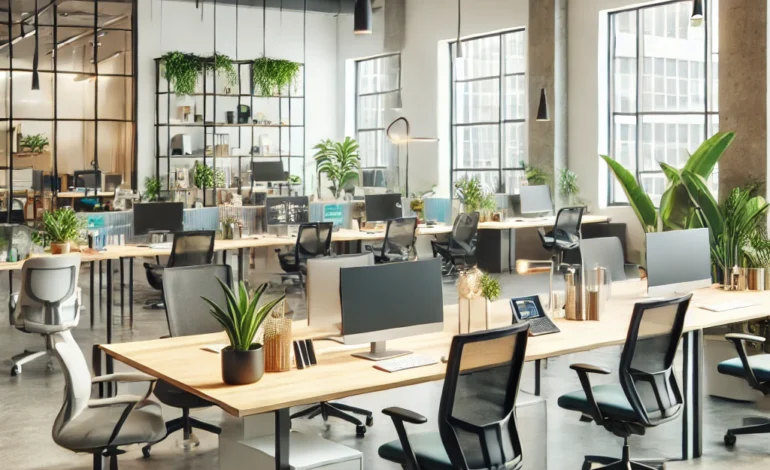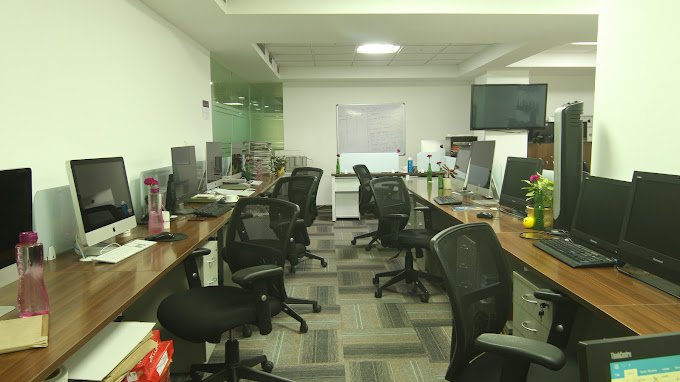How to Design a Productive Workspace in a Commercial Rental
Designing a productive workspace in a commercial rental space is more than arranging desks and chairs—it’s about creating an environment that encourages focus, collaboration, and well-being. Whether you’re setting up a small team office or a large open-plan space, the design choices you make can significantly impact your team’s performance, motivation, and overall productivity. This guide covers the key elements to consider for building an effective workspace in a commercial rental setting, from choosing the layout to integrating technology and considering employee comfort.
1.
Plan a Layout That Balances Openness and Privacy
The layout of your workspace is one of the most critical aspects of office design. Start by understanding your team’s needs, including how often they collaborate, what type of tasks they perform, and their preferences for privacy versus openness. An ideal workspace often combines open areas for collaboration with private zones for focused work.
Open areas should be inviting, with spacious seating arrangements and tables that foster communication and teamwork. These spaces can be enhanced with collaborative tools like whiteboards, projectors, and screens for presentations or remote meetings. At the same time, be sure to incorporate quiet zones or closed meeting rooms for focused tasks. Adding small pods or soundproof booths can also provide employees with options for undisturbed work without requiring a large floor plan.
If you’re seeking flexible workspace solutions, companies like The Office Spectrum’s coworking office spaces in Delhi NCR offer layouts that cater to both collaborative and individual work styles, making it easy to adapt based on team size and activity.
2.
Invest in Quality Ergonomic Furniture for Comfort
Ergonomics should be a top priority in any productive workspace. Employees spend hours at their desks, and uncomfortable or poorly designed furniture can lead to fatigue, discomfort, and even health issues. High-quality ergonomic furniture supports employees’ health and reduces physical strain, allowing them to maintain focus and energy throughout the day.
For chairs, look for options with adjustable height and lumbar support to promote proper posture. Desks should also be adjustable or, ideally, height-adjustable so that employees can alternate between sitting and standing. Adding ergonomic accessories, such as wrist supports, footrests, and monitor stands, can further enhance comfort. These considerations are vital not only for physical well-being but also for sustained productivity. Employees who feel comfortable in their workspace are less likely to experience fatigue or distractions, allowing them to maintain high levels of focus.
3.
Maximize Natural Light and Use Appropriate Lighting
Lighting plays an important role in productivity and mood. Natural light has been shown to improve concentration, reduce eye strain, and enhance overall well-being, so make the most of any windows in your rental space. Position desks and seating areas close to windows to allow employees to benefit from the sunlight.
For spaces with limited natural light, use high-quality artificial lighting that mimics daylight. Avoid harsh fluorescent lights, which can cause glare and strain. Instead, opt for LED lights with adjustable brightness to allow employees to customize their lighting preferences. Soft, warm lighting can create a relaxed atmosphere in collaborative areas, while focused task lighting is ideal for workstations and meeting rooms.
Adding indirect lighting options, such as floor or desk lamps, can create a cozy and welcoming environment, making the office feel more like a comfortable workspace than a traditional office. Prioritizing a well-lit environment contributes significantly to employees’ productivity and reduces the risk of eye fatigue.
4.
Integrate Technology for Seamless Connectivity
Modern workspaces rely on advanced technology for seamless communication, both within the team and with clients or remote partners. High-speed internet is non-negotiable, as it ensures that all devices—from laptops to phones and meeting room screens—can connect quickly without lag or disruptions.
Consider investing in a stable Wi-Fi network with boosters if your space is large, ensuring that there are no dead spots. Equip the workspace with essential tools such as video conferencing systems, interactive displays, and project management software to facilitate smooth collaboration. Meeting rooms should have high-quality screens and microphones to allow remote employees or clients to participate without technical difficulties.
If your team frequently collaborates remotely, using virtual office services, such as The Office Spectrum’s Virtual Business Package, can provide the flexibility needed for hybrid setups. These packages often include virtual addresses and support services, allowing remote employees to feel connected to the physical office.
5.
Add Greenery and Personal Touches for a Positive Atmosphere
A productive workspace doesn’t have to be all function and no aesthetics. Adding plants and greenery can transform an office space, making it feel more refreshing and welcoming. Plants not only enhance the visual appeal but also improve air quality, creating a healthier environment. Low-maintenance options like snake plants, pothos, or succulents are excellent choices for the office, as they require minimal care.
In addition to plants, consider incorporating artwork, color accents, and comfortable furniture that reflect the company culture. These elements can make the space more engaging and help employees feel more at ease. Adding small personal touches, like communal bookshelves, a coffee station, or a relaxing lounge area, can also make the office feel more like a second home. When employees feel comfortable and happy in their workspace, their engagement and motivation tend to increase, which contributes to a more productive environment overall.
6.
Designate Zones for Different Work Styles
Designing a workspace that accommodates different work styles can increase productivity and reduce stress. For example, collaborative areas with large tables and writable walls encourage brainstorming and team discussions, while private cubicles or soundproof booths are ideal for individual, focused work.
It’s also beneficial to have flexible seating arrangements where employees can choose to work in different areas depending on their tasks for the day. This freedom encourages autonomy and allows employees to find the setting that best suits their productivity needs. For instance, an employee handling creative tasks might prefer a quiet space, while someone in a client-facing role might need quick access to collaborative spaces.
7.
Prioritize Security and Privacy
For a productive workspace, ensuring security and privacy is essential. Secure your network with strong passwords and VPNs to protect sensitive information, especially if your team often handles confidential data. Physical security measures, like keycard access or digital locks, can also help control who enters the office and when.
Privacy is equally important. Make sure there are private meeting rooms or zones where employees can have confidential conversations without being overheard. Secure storage options, such as locked filing cabinets, can also help keep valuable documents safe. By taking these steps, you create an environment where employees feel their information is secure, allowing them to focus fully on their work.
8.
Regularly Update and Adjust the Workspace
Workspaces should evolve along with the team’s needs. Conduct regular feedback sessions to learn what employees feel could improve their work environment. Whether it’s adding more collaborative spaces, updating technology, or enhancing comfort options, adjustments based on feedback show employees that their needs are valued.
Maintaining a dynamic workspace ensures that it remains conducive to productivity, even as the business grows and changes. Regular updates to technology, furniture, and even decor can make a significant impact on overall satisfaction and effectiveness within the office.
Make Your Commercial Workspace Work for You
A productive workspace in a commercial rental space is achievable with careful planning and attention to detail. By balancing design with functionality, your office can become an environment that supports both focus and collaboration, enabling your team to perform at their best. Whether you need a flexible coworking space, ergonomic setups, or support for virtual office solutions, The Office Spectrum offers a variety of services to help businesses thrive in their commercial spaces.
Contact The Office Spectrum
If you’re ready to design a productive commercial workspace, reach out to The Office Spectrum for expert assistance:
- Phone: +91-9971714747
- Email: info@theofficespectrum.com
- Address: 362, Aggarwal City Plaza, Mangalam Place, Sector 3, Rohini, Delhi, 110085
- Website: The Office Spectrum
Let us help you build a workspace that fosters productivity, efficiency, and employee satisfaction.



